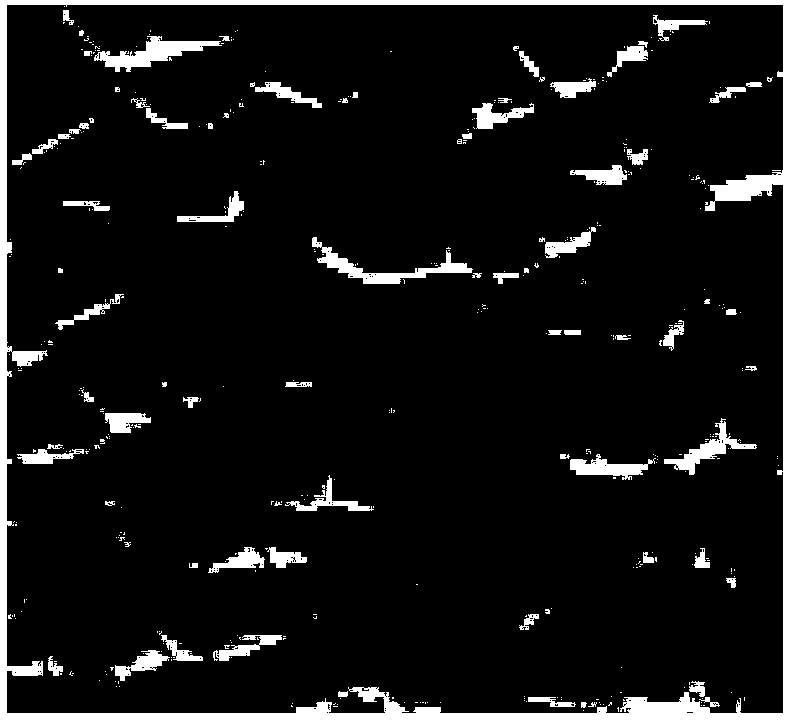Sustained-release system of collagen scaffold loaded with bioactive factors and construction method thereof
A bioactive factor, collagen scaffold technology, used in prostheses, tissue regeneration, coatings, etc., can solve the problems of difficult to control the drug release rate and release amount stably, unstable loaded particles, poor treatment effect, etc. The effect of "burst release" phenomenon, stable and controllable release amount and release rate, and simple construction method
- Summary
- Abstract
- Description
- Claims
- Application Information
AI Technical Summary
Problems solved by technology
Method used
Image
Examples
Embodiment 1
[0075] Example 1 A method for constructing a slow-release system of a collagen scaffold loaded with CBD-bFGF comprises:
[0076] (1) Collagen bundles (the morphology can be referred to figure 2 shown) placed in the CBD-bFGF solution with a concentration of 1ug / ml, 10ug / ml, 20ug / ml, 50ug / ml, and 100ug / ml for 10min~100min (preferably 20min~50min), so that the CBD-bFGF can pass through the specific The recognition function is loaded on the collagen bundle;
[0077] (2) Washing with pure water to remove unbound CBD-bFGF on the collagen bundle after step (1);
[0078] (3) Immerse the collagen bundles completed in step (2) above in PEG solutions with a concentration of 0.1 mg / ml, 1 mg / ml, 3 mg / ml, 5 mg / ml, and 10 mg / ml for 10 min to 100 min (preferably 20 min to 50 min) ), making PEG molecules form a PEG layer on the basis of the above-mentioned support through hydrogen bonding;
[0079] (4) cleaning the collagen bundles completed in step (3) to remove unbound PEG molecules;
...
Embodiment 2
[0087] Example 2 A method for constructing a slow-release system of a collagen scaffold loaded with CBD-bFGF comprises:
[0088] (1) Place the collagen bundles in a CBD-bFGF solution with a concentration of about 10 ug / ml for about 15 minutes;
[0089] (2) Washing with pure water to remove unbound CBD-bFGF on the collagen bundle after step (1);
[0090] (3) Soak the collagen bundles completed in step (2) above for about 10 minutes in a sodium alginate (SA) solution with a concentration of about 2 mg / ml, in which sodium alginate has abundant negative charges, and both CBD-bFGF and collagen have Positive charges can be assembled on the surface of collagen bundles through electrical attraction;
[0091] (4) cleaning the collagen bundles of step (3) to remove unbound sodium alginate molecules;
[0092] (5) Immerse the collagen bundle that has completed step (4) in a collagen solution with a concentration of about 1 mg / ml for about 15 minutes;
[0093] (6) cleaning the collagen ...
Embodiment 3
[0096] Example 3 A method for constructing a slow-release system of a collagen scaffold loaded with CBD-bFGF comprises:
[0097] (1) Place the collagen bundles in a CBD-bFGF solution with a concentration of about 30ug / ml for about 30min;
[0098] (2) Washing with pure water to remove unbound CBD-bFGF on the collagen bundle after step (1);
[0099] (3) Immerse the collagen bundles completed in step (2) above in a heparin (HP) solution with a concentration of about 3 mg / ml for about 30 minutes, wherein the heparin molecules are rich in negative charges and can be combined with positively charged CBD-bFGF and Collagen molecules generate electrostatic attraction, forming a heparin molecular layer on the surface of collagen bundles;
[0100] (4) cleaning the collagen bundles completed in step (3) to remove unbound heparin molecules;
[0101] (5) Immerse the collagen bundles completed in step (4) in a collagen solution with a concentration of about 3 mg / ml for about 30 minutes;
...
PUM
| Property | Measurement | Unit |
|---|---|---|
| concentration | aaaaa | aaaaa |
Abstract
Description
Claims
Application Information
 Login to View More
Login to View More - R&D
- Intellectual Property
- Life Sciences
- Materials
- Tech Scout
- Unparalleled Data Quality
- Higher Quality Content
- 60% Fewer Hallucinations
Browse by: Latest US Patents, China's latest patents, Technical Efficacy Thesaurus, Application Domain, Technology Topic, Popular Technical Reports.
© 2025 PatSnap. All rights reserved.Legal|Privacy policy|Modern Slavery Act Transparency Statement|Sitemap|About US| Contact US: help@patsnap.com



